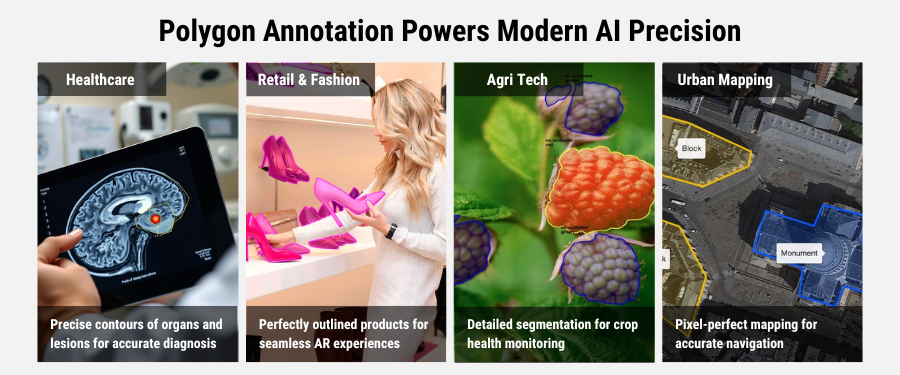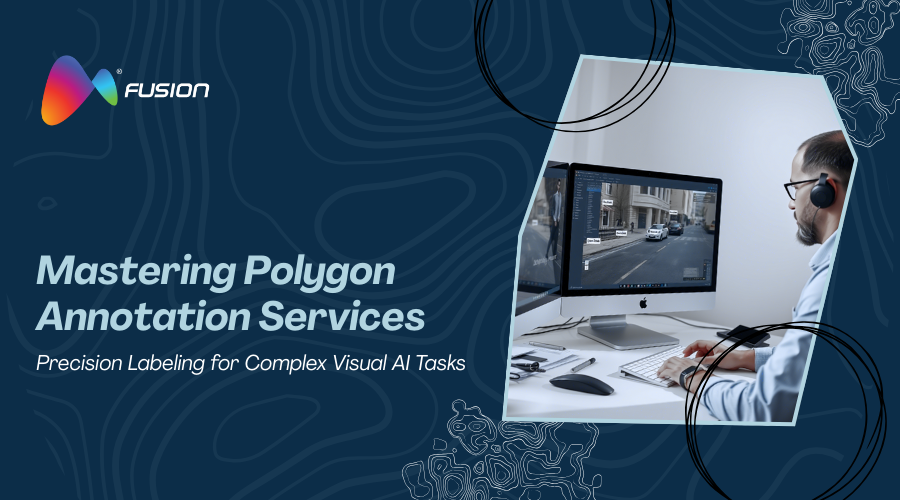Artificial intelligence is transforming how machines interact with the world—but the smarter the task, the sharper the annotation must be. In high-complexity domains where object shapes don’t follow straight lines, polygon annotation services become a necessity, not a luxury. This advanced technique plays a pivotal role in training machine learning models to recognize and respond to the world around them with high levels of detail.
From autonomous vehicles navigating crowded urban streets to medical imaging tools that must distinguish between overlapping organs and tissues, the margin for error in visual AI is razor thin. That’s where polygon annotation comes in. This blog explores how outsourced data labeling solutions are driving the next wave of innovation in machine learning, and why image annotation outsourcing is key to scaling precision AI effectively and affordably.
What is Polygon Annotation?
Polygon annotation services are a specialized form of image labeling that involves drawing a series of connected points to form a precise shape around an object. This shape, or polygon, can closely contour to the edges of irregularly shaped objects. Unlike standard bounding boxes, which draw a rectangle around an object (often including unnecessary background), polygons can map the object’s unique outline with near pixel-perfect precision.
This makes polygon annotation indispensable in use cases where the visual content is intricate, such as:
- Segmenting trees, fruits, or plants in agricultural drone imagery
- Outlining internal organs, tumors, or bones in radiology scans
- Mapping complex road structures, sidewalks, or lane markings in autonomous driving systems
- Labeling overlapping items or irregular shapes in retail product images
In these scenarios, traditional box annotations fall short, often leading to noisy data that degrades model accuracy. Polygon annotation services enable AI to learn from clean, high-fidelity visual data that mirrors the complexity of real-world objects.
Why Polygon Annotation Matters in Modern AI
Modern AI models, especially those working in computer vision, are only as smart as the data they’re trained on. And for certain applications, that data needs to be incredibly specific. Whether it’s recognizing the difference between a healthy plant, and one affected by disease or navigating a tight city intersection filled with road signs and foot traffic, precision matters.

In industries where detail is everything, polygon annotation provides that next-level accuracy. For instance:
- Healthcare: When annotating MRI or CT scans, medical professionals and AI models need to see the exact contours of internal organs or lesions. A bounding box might include irrelevant tissue, skewing results. Polygon annotation services give a precise outline, supporting accurate diagnostics.
- Agri tech: In satellite or drone imagery of farmlands, farmers can use AI-powered insights to detect irrigation issues, soil inconsistencies, or crop diseases. These systems depend on annotated images where every tree canopy or crop row is accurately segmented.
- Retail & Fashion: For AR applications, such as virtual try-ons or visual search tools, AI must recognize the edges of garments or accessories. Loose annotations lead to misaligned experiences, while polygon annotation enables a perfect fit.
- Urban Mapping: City planners and navigation apps need pixel-perfect data on roadways, sidewalks, and building edges to model realistic environments. Polygon annotation services help achieve that precision.
The Challenges of Scaling Polygon Annotation In-House
Despite its many advantages, polygon annotation is labor-intensive and can quickly drain resources if handled internally. It’s not just about drawing shapes—it’s about doing so consistently, quickly, and at scale.
Here are some of the top challenges companies face when attempting to handle polygon annotation services in-house:
- Time Consumption: Labeling images using polygon annotation is inherently slow. Each shape requires careful attention to detail, with many points needing placement to contour the object accurately. Multiply that by thousands of images, and your annotation timeline balloons.
- Need for Expert Annotators: Not everyone can annotate complex shapes accurately. It requires training, practice, and industry-specific knowledge. Hiring and retaining such talent in-house adds to operational overhead.
- Tooling and Infrastructure: Effective polygon annotation requires advanced software tools with zooming, vector control, snapping, and validation features. Building or licensing these tools can be costly.
- Quality Assurance Burden: Without a dedicated QA team, annotation errors may go unnoticed. These mistakes can lead to model misinterpretation and long-term performance losses.
Why Fusion CX is the Smarter Choice for Image Annotation Outsourcing
Outsourcing image annotation is not just a tactical decision; it’s a strategic advantage, especially when precision, scalability, and speed are non-negotiable. At Fusion CX, we deliver all this and more by combining top-tier human talent with cutting-edge tools. Whether you’re looking to ramp up AI development or offload tedious labeling tasks, our solution is designed to adapt to your workflow and scale with your needs.
Outsourcing with Fusion CX brings immediate benefits to organizations aiming to scale their AI and machine learning initiatives. It alleviates operational pressure while ensuring that trained professionals handle annotation work with access to best-in-class platforms and processes.
Here’s what sets Fusion CX apart:
- Access to Skilled Annotators: Our dedicated teams are well-versed in various annotation formats and industries, from healthcare to agriculture. They deliver accurate results quickly and are ready to be onboard on your projects with minimal ramp-up time.
- Faster Turnaround: Our ability to scale resources dynamically means we can process massive datasets within tight deadlines without sacrificing quality.
- Cost Efficiency: You only pay for high-quality output, eliminating the overhead of hiring, training, and managing internal annotation teams and infrastructure.
- Custom Guidelines and Tool Agnosticism: Every project starts with a collaborative setup phase to align on annotation standards. We work seamlessly with your in-house tools or provide access to ours — whatever fits your ecosystem.
- Scalable Infrastructure: With hundreds of annotators and cloud-powered delivery models, we handle large-scale image annotation without bottlenecks.
- Quality and Speed Balance: Our structured workflows include parallel processing and multi-layered QA to ensure accuracy and throughput.
- End-to-End Security: Your data is protected by robust privacy policies and compliance with global standards like GDPR and HIPAA.
- Focus on Innovation: By entrusting the annotation workload to us, your internal teams can focus on developing models, refining algorithms, and driving strategic initiatives.
Whether you need to annotate 50,000 images this month or scale up to 100,000 next quarter, Fusion CX is built to flex. We’re not just a service provider—we’re your long-term data partner, committed to helping you build smarter AI systems with better training data.
Conclusion
Polygon annotation services are the precision engine behind complex AI tasks. They allow your models to understand intricate details, navigate complex environments, and deliver reliable outputs. But achieving this level of data quality requires more than just effort—it requires expertise, tools, and scale.
By embracing outsourced data labeling solutions, businesses can unlock faster development cycles, better-performing AI, and lower overhead. With the right partner like Fusion CX, your annotation needs are handled with care, so you can stay focused on innovation.
Ready to unlock the power of polygon annotation services? Contact Fusion CX today to explore tailored annotation solutions that scale.
Read more blogs: Strategic Polygon Data Labeling: Define the Next Generation of Intelligent Vision Systems

